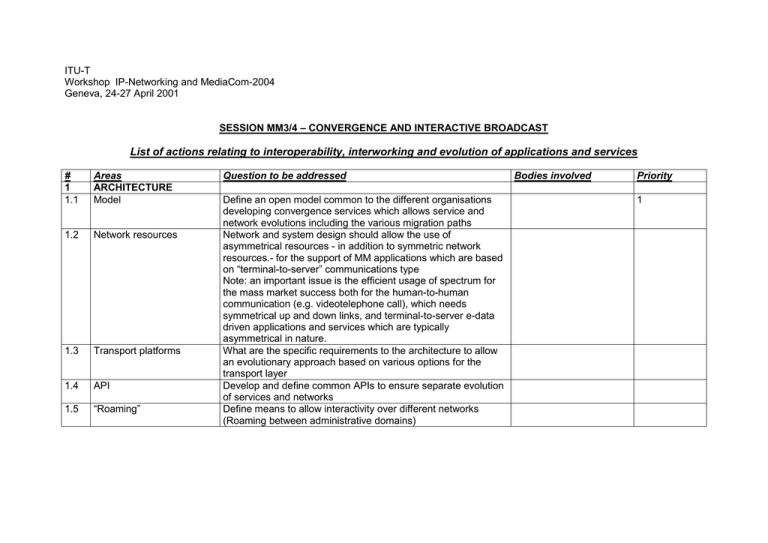ITU-T Workshop IP-Networking and MediaCom-2004 Geneva, 24-27 April 2001
advertisement

ITU-T Workshop IP-Networking and MediaCom-2004 Geneva, 24-27 April 2001 SESSION MM3/4 – CONVERGENCE AND INTERACTIVE BROADCAST List of actions relating to interoperability, interworking and evolution of applications and services # 1 1.1 Areas ARCHITECTURE Model 1.2 Network resources 1.3 Transport platforms 1.4 API 1.5 “Roaming” Question to be addressed Define an open model common to the different organisations developing convergence services which allows service and network evolutions including the various migration paths Network and system design should allow the use of asymmetrical resources - in addition to symmetric network resources.- for the support of MM applications which are based on “terminal-to-server” communications type Note: an important issue is the efficient usage of spectrum for the mass market success both for the human-to-human communication (e.g. videotelephone call), which needs symmetrical up and down links, and terminal-to-server e-data driven applications and services which are typically asymmetrical in nature. What are the specific requirements to the architecture to allow an evolutionary approach based on various options for the transport layer Develop and define common APIs to ensure separate evolution of services and networks Define means to allow interactivity over different networks (Roaming between administrative domains) Bodies involved Priority 1 2 2.1 Services/Applications Model 2.7 Definition of a model common to the different organisations developing convergence services which is open and allows service and network evolutions including the various migration paths Definition and description Develop a service description model which includes attributes like bit-rate, pt to multipoint/multicast/anypoint (including webcasting), real time/non-real time, etc… considering also the impact on architecture. Customization Service model and description should support the customisation of services (e.g. bundling of services) Locations based services Service model and description should allow the provision of services based on location information in the mobile and ecommerce areas including the requirements specific to these two areas Business models Service models and description methods should support specific business models and their evolution in the MM scene (e.g. content oriented, transport oriented, etc…) Digital Rights Management Need for support for Digital Rights Management was recognized. Digital Cinema Identify the impact on the A/V codecs and transport networks 3 3.1 Media Coding Model 3.2 Speech recognition 4 4.1 Terminals Model 2.2. 2.3 2.4. 2.5 2.6 Bodies involved Priority Bodies involved Priority Bodies involved Priority Development of a functional model including generic requirements to avoid the proliferation of incompatible codecs Develop a study programme which cover the need for the various applications (voice control, speaker identification, etc…) Develop a model common to the different organisations developing convergence services which would ease interoperability and take care of the various transport platforms used as well as the environment they are used (mobile, fix, office, home, etc…) 5 5.1 Other issues Definitions 5.2 Spectrum 5.3 Business cases 5.4 Service provisioning and regulatory framework 5.5 Service and network evolution Bodies involved Convergence has different meaning across the different industries and there is a need to consider convergence and its impact from these different viewpoints. Improve the coordination between the network/system/service designers and the bodies dealing with spectrum issues (allocation, propagation, sharing, etc…) with the aim to specify standards which are implementable and market-oriented Improve the coordination among the different organisations developing convergence services to define market expectations based on technology, evolution, economics, regulatory framework, etc.. Improve the coordination among the different organisations developing convergence services in order to better assess the impact of the regulatory framework on the provisioning of MM services Improve the coordination among the different organisations developing convergence services in order to address evolution scenarios that ensure interoperability under the various environment (legacy systems, economics, teledensity, regulatory framework, etc…) Priority







